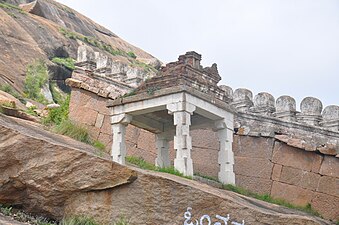Shivagange
Sri Honnammadevi Temple is inside the cave. Sri Gavi Gangadhare Temple is also inside the cave. Gavi means Cave, Gangadhareshwara means Parameshwara having Gange on the top. Every January, on the day of Sankranthi festival, the marriage function of Sri Gangadhareshwara and Sri Honnammadevi (Parvathi) is conducted. At that time it is claimed Ganga holy water comes from the rock at the top of hill and that holy water is used to solemnise the dhare ritual of the marriage function.
History
Sivaganga is a sacred hill with a height of 4,559 feet above the level of the sea. Its outline appears from the east as a bull, from the west as a Ganesha, from the north as a serpent, and from the south as a linga. The number of steps leading to the top is said to equal the number of yojanas to Benares(Varanasi).Hence this is called Dakshina Kashi. An ascent to the top is considered as a pilgrimage to the holy city.

The puranas give it the name of Kakudgiri. It is mentioned by its present name in the 12th century as one of the distant points to which the Lingayat faith established by Basava, the minister of Bijjala, king of Kalyana.
During the reign of Hoysala kings, the queen Shanthala, wife of Vishnuvardhana, who committed suicide from this hill as she did not give birth to a son.
The hill was fortified during the 16th century by Shivappa Nayaka. These fortifications currently lie in ruins. The founder of Bengaluru, Magadi Kempegowda, also made improvements to the fortifications and kept a portion of his treasure within it.
A month-long cattle fair is held during Sankranthi month (around January) every year, which is a market place for bullocks.
Beliefs surrounding the Gavi Gangadhareshwara Temple in Bengaluru
Followers believe an interesting miracle happens when abhisheka is performed on Shivalinga with ghee, the ghee turning to butter. It is claimed by the devotees/believers that this ghee has medicinal powers and can cure many ailments. According to legend there exists a secret tunnel that extends from the sanctum sanctorum (Garba Griha) of this temple to the Gavi Gangadhareshwara temple in Bengaluru, around 50 km (31 mi) away.
River Kumudvathi
River Kumudvathi has its origin in the Shivagange hills and it is a tributary of river Arkavati. The Kumudvathi river flows across 278 villages covering 460 km (180 sq mi) encompassing major part of Nelamangala Taluk, Bengaluru Rural District and parts of Magadi Taluk, Ramanagra district. Due to various factors like deforestation, unsustainable extraction of ground water, soil erosion, encroachments and eucalyptus plantations the river has dwindled in size. This has resulting in serious water crisis for drinking and agriculture in all the villages under the river basin. However, projects and efforts are underway to revive the river.
Trekking
The area is a popular site for rock climbing in the Karnataka state. The entire trail to the peak is well marked and the presence of human-made steps (often carved into the rocky landscape, but sometimes made from rocks) makes the trail suitable for beginners. There are frequent rest opportunities with stalls serving food and drinks. The trekking path to reach summit from foothills is of 6 km (3.7 mi) in a pre-defined path. The trail becomes steep and narrow near the summit of the mountain - safety rails are provided in such areas. Monkeys are the main fauna inhabiting the hill.
Protected monument
The temple shrine is a protected monument under the Karnataka Ancient and Historical Monuments and archaeological sites and remains act 1962.
-
A temple on top
-
Basavanna
-
Olakal Theertha
-
Architecture
-
Shiva Parvathi
-
Architecture
-
Veerabhadra Swamy
-
Basavanna
-
Olakal Theertha
References
- ^ "Shivagange". Bangalore rural district. Retrieved 14 February 2022.
- ^ Benjamin Lewis Rice (1876). Mysore and Coorg: A gazetter compiled for Government of India.
- ^ "Shivaganga, Tumkur District, Karnataka, India". charmingindia.com. Archived from the original on 15 March 2014. Retrieved 14 March 2014. |
- ^ S.V. Charya, Upendra (2014). "Shivagange and its fort". Deccan Herald, Bangalore. Retrieved 14 March 2014.
- ^ "Shivagange – A world of adventure, mystery and legends". Karnataka.com. Retrieved 14 March 2014.
- ^ "Revive Kumudavathi". revivekumudvathi.org. Archived from the original on 7 January 2017. Retrieved 15 February 2017.
13°10′11″N 77°13′22″E / 13.16970°N 77.22265°E








